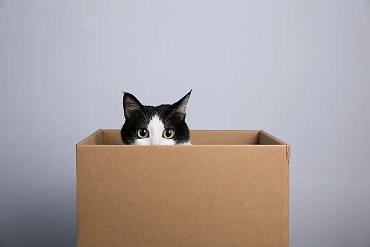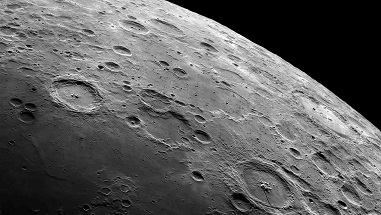|
home | what's new | other sites | contact | about |
||||||
|
Word Gems exploring self-realization, sacred personhood, and full humanity
Quantum Mechanics
return to "Quantum Mechanics" main-page
Editor’s note: Please review the elements of this debate in Part I.
Editor’s restatement: 'Schrodinger’s Cat' does not represent the real world nor real science A friend sent me this “science humor” item:
This little photo-illustration represents the popular, but quite errant, view of "Schrodinger’s Cat" philosophy. Today millions believe that “the cat is neither dead nor alive” until the box is opened and an observing consciousness “takes a measurement.” But this is not true. The many interpretations of “Schrodinger’s Cat” point out the issues of confusion, but allow me to categorize them one more time, plus add one or two items of my own. “Schrodinger’s Cat” is part of the 1927-1935 Bohr-Einstein EPR Paradox debate. In a paper published in 1935, Schrodinger put forward his famous cat thought-experiment. Schrodinger was an ally of Einstein against Bohr, and his "cat" was meant to support Einstein. Einstein-Schrodinger were losing the debate with Bohr-Heisenberg. “Schrodinger’s Cat” was a kind of “Attorney’s Last Resort” tactic (see on the “Clear Thinking” page) to slow the advance of the Copenhagen Interpretation. “Schrodinger’s Cat” is meant to be sarcastic, mocking, and derisive toward the views of Bohr-Heisenberg. “Schrodinger’s Cat” is not real science, not based on good empirical evidence, no matter what we’ve heard from Hollywood and the popular press. “Schrodinger’s Cat” does not accurately represent the views of Bohr-Heisenberg but, instead, creates a straw-man version of the Copenhagen Interpretation, a carefully crafted misrepresentation, allowing Einstein-Schrodinger to gain points in the debate, and seemingly win, but only by skewing the statements of Copenhagen. Let’s take a step back and see that “Schrodinger’s Cat” is but another formulation of a view that had bothered Einstein for a long time. On the “quantum homepage,” these inset boxes were featured:
In other words, Einstein was troubled by a too-facile view of reality which suggested that an observing consciousness could cause objects of the universe to pop in and out of existence. He was right to raise a hand of demurral - but this is not, strictly speaking, what Copenhagen was saying, and therefore a straw-man issue. Since Einstein wondered about the fate of the Moon if we’re not looking at it – another mocking attempt to disparage the Bohr-Heisenberg position – let’s create our own “Schrodinger’s Cat” thought-experiment, but on a very large scale. Schrodinger’s Moon In this thought-experiment, instead of a cat we have the Moon as subject. Instead of a hidden cat in a box, we can avert our eyes from the Moon so as to not see it. Instead of a possible release of poison gas for the cat, we postulate a cache of nuclear explosives on the Moon, large enough to shatter it. Now, like the glass vial of poison, the nuclear explosives are also potentially activated by the half-life of atoms. So, what do we have? If we turn our backs to the Moon, we can no longer see it; the cat is now placed in the box, and we no longer see it. In one hour, the potentially decaying atoms will have activated a destructive device; which is to say, in one hour, the fate of both the cat and the Moon will be decided. Decided by what? a natural process of 'random draw' will determine whether the atoms decay, or not decay, in the next hour; this goes on all the time without any observing consciousness The so-called power of the observing consciousness has nothing to do with it. The “measurement”, if we must employ the term, takes place on the level of the potentially decaying atoms. The atoms will decay or not decay during the next hour, and will do so quite independently of our supervision. According to Schrodinger's paper, a real cat was to be placed in the box. Did it suddenly phase into some sort of ethereal “superpositional state” just because we closed the lid of the box? And did the Moon suddenly blank-out of existence just because we turned our eyes? – and left both of these hapless entities to the mercies of the probabilities of atoms’ half-lives? This is rubbish. Of course the very real Moon didn’t disappear, and of course the very real cat is still pacing inside the box – as both of these await their fates. And that fate will come, in either instance, whether we know about, or supervise, it or not. a falsified representation of the EPR Paradox debate It’s been pointed out, by Scientific American and other sources (see on the main-page), that the entire crux of the “quantum debate” revolves about the question, what happens during the wave-function phase? Are the entangled particles real particles, part of the 3-D universe, before a measurement is taken? – or are they not yet real particles but only “probable particles” existing, as Heisenberg used the term, “in potentia”? The EPR Paradox debate, from the perspective of Bohr-Heisenberg, is not about real particles on their way to a measurement, but potential particles. “Schrodinger’s Cat” is meant to ridicule Copenhagen, but it falsifies the entire process. A real live cat, according to Schrodinger’s paper, is placed in the box. But a “real live” particle does not commence the entanglement journey, as per the position of Bohr-Heisenberg. We need to be aware of this crucial difference. And so “Schrodinger’s Cat” is meaningless as it fails to accurately represent the statements of Copenhagen. It's not science. “Schrodinger’s Cat” is just glitz and showmanship, part of an image-building propaganda effort. And this little cartoon is more rubbish. If this were to accurately represent the EPR Paradox debate, the plates would not even exist before the measurement. There is no intermediate state of half-smashed and half-intact. This is a perversion of real science.
|
||||||
|
|


